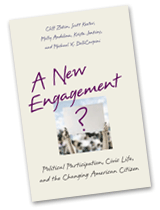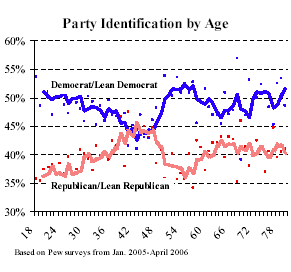by Scott Keeter

What’s the new generation coming to? Are today’s young people apathetic and politically inert, as the stereotypes suggest? Are they more reluctant to get involved in politics and public life than generations past? What will American politics be like when they are eventually in charge? The answers are not what you might think. Not only is there evidence of a reawakening of young people to public life, but today’s youth are politically distinctive in many ways.
First, let’s be clear who we are talking about. This is not “Generation X.” The youngest GenXers are turning 30 this year, and some of them are over 40 now. Instead, we are focusing on the next generation — those in their teens and 20s today — who are sometimes labeled as “Millennials,” “Gen Y,” or “Gen Next.” Our book1 calls them the “DotNets,” because of their technological savvy. Though there is no clear line dividing one generation from another, the boundary falls around 1976. Kids born after that year began coming of age in the 1990s and have experienced a very different social and political world than did Generation X, whose formative years were the 1980s.

It’s true that over the past three decades, youth have been disengaging from conventional politics. In particular, electoral participation by America’s youngest citizens has experienced a long, slow decline. In most elections since 18- to 20-year-olds were given the vote, voter turnout among younger Americans has fallen, and, indeed, has accounted for most of the drop in voter turnout overall in the United States during that period.
Young people have also shown other signs of disengagement from political life. In Pew Research Center polls over the past two decades, the percentage of the youngest age cohort registering a complete lack of attention to politics rose from 12% (in 1987-1988) to 24% in 2002-2003. Similarly, while 47% of young adults ages 18-29 were daily newspaper readers in 1972, by 2004 the number among the same age group had plummeted to 23%. Moreover, that earlier cohort has continued to read newspapers at the same rate as they have grown older (they are now mostly in their 50s). It appears that newspaper reading is a habit developed early in life. Once developed, it continues, but if it isn’t started, it may never be undertaken.

The news is not all bad, however. The trend in falling voter turnout among young people was reversed in 2004. Among the voting age members of the DotNet cohort (ages 18-29), 49% voted, an increase of 9 percentage points from 2000. While young people still lag behind older adults, the rise in voter turnout among those ages 30 and older was a much more modest 3 percentage points – from 65% to 68%.
Young people were also active in other ways in the 2004 campaign, matching or exceeding the Baby Boomer cohort in several campaign activities such as displaying buttons, signs, or bumper stickers, attending rallies, or trying to persuade others how to vote.
And electoral activity isn’t the only story. Young people are active in public life in many other ways not reflected in the voting statistics. According to our 2002 study of 3,246 people – including 1,001 DotNets, many are engaged in volunteer activities and community problem-solving, and even more voice their opinions on public issues through the internet and more conventional media.
About four-in-10 DotNets now say they have done some type of volunteer work in the past year, and 22% had volunteered regularly. These numbers were similar to those for all age groups. And UCLA’s annual survey of college freshmen has documented a growing trend of volunteer activity over the past 15 years.
Young people also match their elders in working with others to solve community problems, and are active in fund raising for charitable causes as well.
Similarly, across a wide range of ways in which people try to make their voices heard beyond the electoral process, young people are holding their own. Our survey showed that, compared with GenXers and Baby Boomers, comparable numbers of those ages 15-25 had contacted a newspaper or other news medium to express their opinion, signed a petition, participated in a protest, or boycotted a company or product for political reasons. Young people trailed their elders only in contacting public officials; compared with Boomers, only half as many of the youngest cohort had called, visited, or written a public official in the past year (10% vs. 20%).
In short, the stereotype of a politically disengaged younger generation is not fully accurate. As has long been true, young people don’t match their elders in voter turnout or many other traditional forms of political engagement. But the gap between younger and older citizens narrowed in 2004, and there are clear signs that youth are increasingly finding other ways to be involved in public life – engagement that may eventually broaden to include more voting and other electoral activities.
What values and opinions do today’s youth bring to their public engagement? How are these views likely to affect American politics and public policy as the DotNet generation moves into positions of responsibility in government, business, education, and the non-profit world?
Today’s younger Americans are more liberal than the country as a whole on many social issues, with one or two surprising exceptions. And while they are generally more favorable toward government activity including regulation, they also have positive views of business.

In partisan terms, there is dramatic evidence for a generational divide. Young people today are much more likely to identify or lean Democratic rather than Republican, especially compared with the GenXers and late Baby Boomers who are in their 30s and 40s today. For example, among 18-24 year olds in Pew surveys over the past year and a half, fully 51% say they are Democrats or lean to the Democratic Party; just 37% are Republicans or lean to the GOP. By contrast, Republicans match the Democrats among those 40-44 years old (43% Republican, 45% Democrat) – those Americans who came of age during the Reagan years.
In fact, the partisan leanings of DotNets today mirror their parents’ generation – many of whom are in the first half of the Baby Boomer cohort. Among Baby Boomers who came of age during the late 1960s and early 1970s – those roughly ages 50-59 now – party identification is nearly the same as among the DotNets: 51% Democratic or leaning, 38% Republican.

The youngest generation is most distinctive on social issues, notably questions about gay marriage and interracial dating. For example, a Pew poll in March found 58% of those ages 18-29 favor allowing gays and lesbians to adopt children. Among no other age group did as many as half favor this. Similarly, 48% in a July 2005 Pew poll supported gay marriage, significantly more than in any other age group.
Young people are also much more comfortable with diversity. In a 2003 Pew survey, 68% “completely” agreed that it’s “all right for blacks and whites to date each other.” Just 42% of respondents 30 and older felt that way.
But the social liberalism of the young does not extend to one of the signal issues of our day: abortion. Just 31% of people ages 18-29 told Pew that they believed abortion should be “generally available.” Among those 30 and older, 37% said that abortion should be generally available.
Younger Americans are generally more positive than older Americans regarding the efficiency of government and the job it does in regulating business and helping the disadvantaged. Yet they are also more favorable toward business on some questions. Younger Americans were also substantially more likely than other age groups to favor President Bush’s proposal to create private accounts in the Social Security system.
Of course, there’s no guarantee that opinions held today by young people will still be their views when they are older. People do change. But many fundamental values and political orientations are likely to be much the same as they grow older – for example, we can still clearly see the imprint of the 1960s and 1970s on the Baby Boomer generation’s party identification – and thus it’s worth considering what the future might look like when this group of younger Americans finally takes its turn running the country.
Based on the uptick in voter turnout among DotNets in 2004, their relatively high levels of civic engagement, and their willingness to express their opinions to political leaders, the media, and their peers, this cohort of Americans is not likely to be a silent generation.
Notes
1Scott Keeter, Director of Survey Research for the Pew Center for the People & the Press, is co-author of A New Engagement? Political Participation, Civic Life, and the Changing American Citizen (with Cliff Zukin, Molly Andolina, Krista Jenkins, and Michael X. Delli Carpini). Published this month by Oxford University Press.




